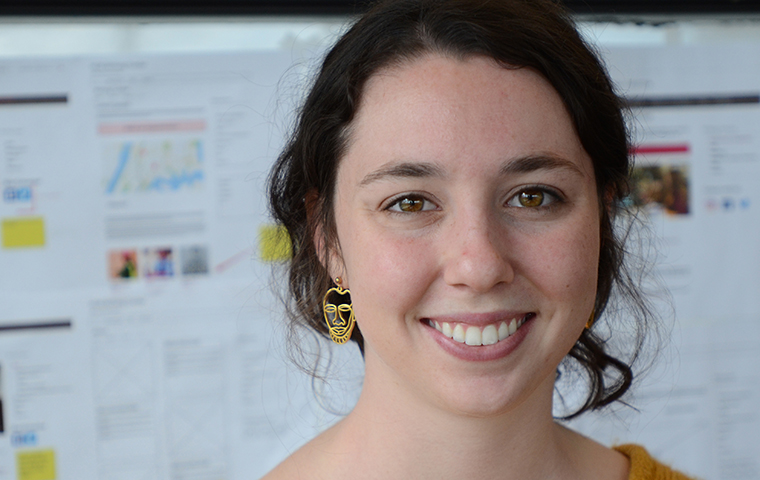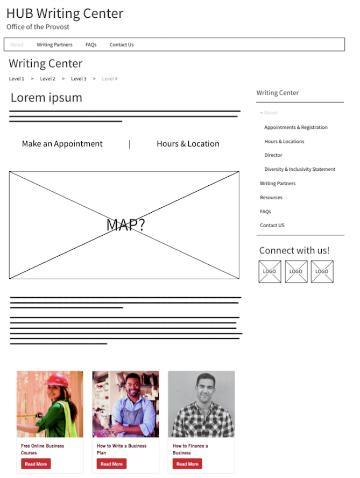
Designing Your Own Experience
Through a user experience design internship, English major Mara Strong ’20 found her place in Silicon Valley.
Mara Strong ’20 can’t wait for the new version of The HUB to launch this summer. The homepage for SCU’s writing resource center will be more intuitive. It will have fewer subpages, which means fewer clicks. It will have a “make an appointment” button that actually makes an appointment instead of sending the user to a different page.
“All the key information is placed strategically,” Strong says. “We made it much more visually appealing but at the same time it gets the user where they need to go.”
For the past three months, Strong was an intern on a user experience (UX) design team in ENGL 198C. Each quarter, the internship program, run by the Department of English, tasks a group of student interns with improving the user experience of a different University website. This quarter’s project was for The HUB, which offers students tutoring in writing and public speaking.
The HUB serves a valuable role on campus, but its website’s navigation structure—full of redundant information and dead links—got in the way of serving its audience, making it a perfect candidate for the internship.
For the uninitiated, the goal of UX design is to make websites better—not necessarily flashier, but easier to use and more compelling. UX designers create websites that get users the information they seek in the most intuitive way possible.
The way UXers accomplish this is by joining expertise in design and communications with first-hand data. Essentially, listening to the site’s typical user, identifying their habits, needs, behaviors, motivations, and emotions, and then finding a solution.
To start the project, Strong and four fellow interns—Jane Mezzino ’20, Claire Lindstadt ’22, Jack Miller ’20, and Powell Clark ’22—completed an assessment of the functionality of The HUB website. Then they conducted user research, produced wireframe proposals (or a skeleton structure for the webpages), and worked with Denise Krane, director of The HUB, through iterations to refine the final product.
The UX team considered lots of different options—everything from the general site structure to whether the navigation terms should be nouns or verbs—before settling on a final design.
“Previously, the website was a little confusing and now we’ve designed it to front load all the important information based on why users go to The HUB website,” Strong says. “A lot of the pages were four to five clicks deep from the homepage, which is a lot. That’s a whole maze. So we’ve cut it down.”
Tech and the Humanities
Strong is a quintessential liberal arts student. A lifelong book-lover, she knew she wanted to major in English since high school. At Santa Clara University, she’s continued to explore her interests, adding history and philosophy minors to her workload.
Though Strong has loved her coursework, she wasn’t sure how to translate those skills into a career path after college. When she saw an email about the UX design internship, she thought she’d give it a shot.
Julia Voss and Heather Turner, both assistant professors in the Department of English, developed the internship this year to offer guidance in a blossoming field where the skills of English majors—and the humanities in general—are highly valuable.

A wireframe created by students for The HUB website.
Turner has more than a decade of experience in UX design, starting with non-profits after she graduated from college. She taught grassroots organizers how to take the story they were already telling well on the streets and translate it to websites and social media. When she started her Ph.D., she continued her research and ultimately wrote her dissertation on the topic.
The Internship For First-Years
In addition to getting English students interested in a growing field, the internship also gives students valuable experience early in their college career.
“We noticed a lot of off-campus internships actually require a ton of experience,” Turner says. “We designed this so you don't have to have a lot of previous experience to get in.”
Each quarter starts in a space where most students are already comfortable—as Internet users. Turner asks students to examine which websites they like, which they don’t, then try to figure out why they feel that way. From there, the students apply what they’ve learned to the project for that quarter.
Turner structured the projects to function like a real job where students are the vendor and the campus partner is the client. There are weekly standups, assignments, progress updates, client meetings, deadlines, and deliverables. At the end, each student has a portfolio and completed assignment to add to their CV.
For Strong, she’s found a possible direction in life after college. She plans on exploring internships in UX outside SCU this summer and then full-time positions when she graduates in 2020.
“It’s a field where anything goes, which I love about it.” Strong says. “As long as it gets the job done and is effective and helps the user, it’s good to go.”
Mara Strong ’20 loves the freedom and creativity offered by UX design: “It’s a field where anything goes. ... As long as it gets the job done and is effective and helps the user, it’s good to go.”